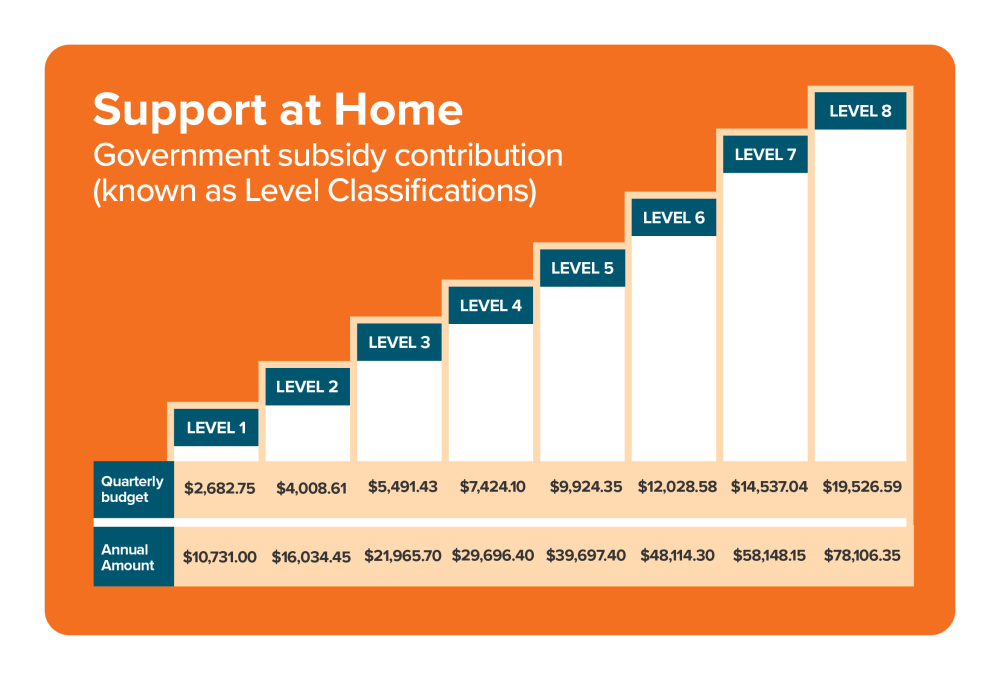This new system aims to improve in-home care by reducing wait times, increasing access to services and ensuring funding is based on individual needs.
Eight levels of tailored support
- More flexibility to match individual care needs.
- Shorter wait times – Faster access to services and interim funding while waiting.
- A single assessment system – Aligned with all aged care funding types.
- Three funding categories – Clinical Care, Independence Support, Everyday Living
- Assistive technology and home modifications – Separate funding available on application
- New service options - including end-of-life and short-term care
Who is eligible?
Home Care Funding and Your Contributions
The government will continue funding in-home care, but some cost-sharing changes will apply. Instead of set fees, contributions will be based on the type of service received and financial means.
| Type of Service | Government Funding | Client Contribution |
|---|---|---|
| Clinical care Services under this category include clinical nursing care, physiotherapy, and other Allied Health services. Care Management also falls under this category. |
Fully funded via your package | No cost to client |
| Independence support Services under this category include personal care, social support, respite, and transport. |
Partial funding via your package | Moderate contribution |
| Everyday living Services under this category include domestic assistance including cleaning, meals, gardening, and home maintenance. |
Partial funding via your package | Higher contribution |
Full pensioners will pay between 5%–18% for non-clinical services with the new Support At Home classification. We’ve summarised the co-contributions in the table below:
| Clinical Care Support | Independence Support | Everyday Living Support | ||||
|---|---|---|---|---|---|---|
| Before 12 September 2024 | After 12 September 2024 | Before 12 September 2024 | After 12 September 2024 | Before 12 September 2024 | After 12 September 2024 | |
| Full Pensioner | 0% | 0% | 0% | 5% | 0% | 18% |
| Part Pensioner | 0% | 0% | 0%-25% | 5%-50% | 0%-25% | 5%-50% |
| Self-funded retiree (holding or eligible for a Commonwealth Seniors Health Card - CSHC) |
0% | 0% | 0%-25% | 5%-50% | 0%-25% | 5%-50% |
| Self-funded retiree | 0% | 0% | 25% | 50% | 25% | 80% |
Unused funds will roll over each quarter, but only up to $1,000 or 10% of the quarterly budget.

More Support Levels and Pathways
The Support At Home program offers eight funding levels. The highest level offers up to $78,000 per year.
Two short-term care pathways are also available:
- Restorative Care (6–12 weeks) – Helps regain independence and delay higher care needs.
- End-of-Life Care (12 weeks) – Provides enhanced in-home support for terminally ill individuals wishing to die at home.
Assistive Technology and Home Modifications
A separate Assistive Technology and Home Modifications (AT-HM) Scheme provides funding for equipment and home modifications, with three funding tiers:
| Tier | Funding Cap* |
|---|---|
| Low | $500 |
| Medium | $2,000 |
| High | $15,000 |
Some co-contributions may be required for higher-cost items. Learn more about Assistive Technology and Home Modifications
*Time limits apply to these funds
How Benetas Can Help You Navigate Home Care
The Support At Home program aims to make home care simpler, fairer and more effective for older Australians. It provides us with a once-in-a-generation opportunity to redesign the system and enable a better experience for Australians who choose to remain in their homes as they age. Whether you’re already receiving care or planning ahead, it is important to understand the system to help you make informed decisions and the right choices for your unique circumstances.
At Benetas, we’re committed to guiding you through this transition no matter where you’re at in your journey.
Contact us for more information and tools to help you navigate government funding or shopping for a home care provider.